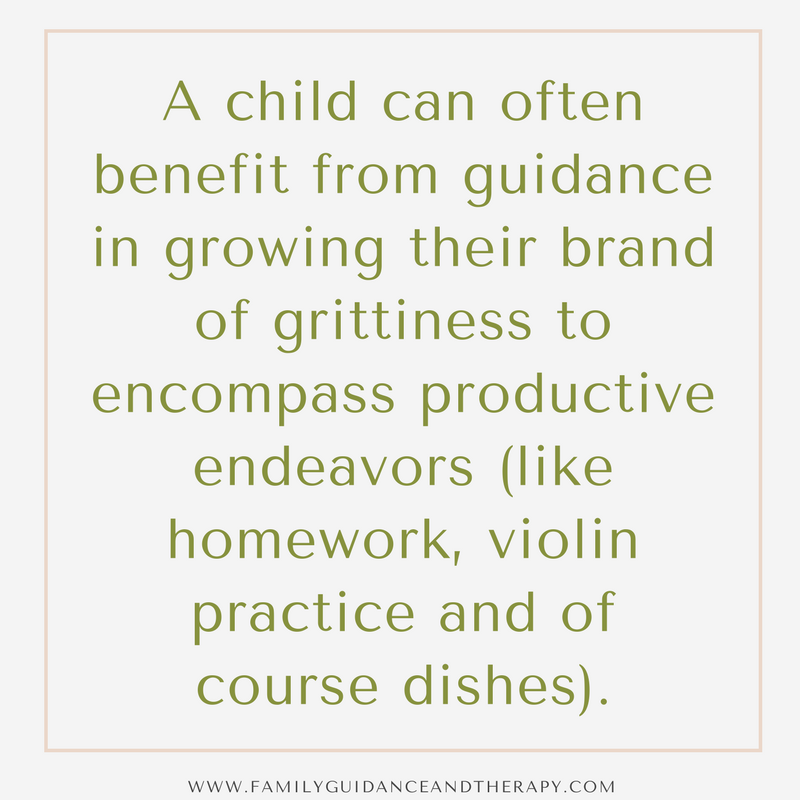Most people have more grit than me. I completed the Duckworth grit scale and got a 2.8, which is higher than about 20% of American adults. I was initially surprised but the reality is I am far more likely to modify my goals than I am to meet them and the very idea of persevering in the face of high adversity gives me nightmares of girls’ junior softball circa 1994. I like to do what I am good at and I like to be good at things I enjoy doing. Of course, that doesn’t mean I don’t know how to stick with necessary things - laundry, mopping, dishes, dishes, more dishes.
Grit, like every other trait (or skill), has a broad range of variability and will manifest differently in everyone. Angela Duckworth, University of Pennsylvania psychologist and MacArthur 'genius' defined “grit” as working strenuously toward challenges, maintaining effort and interest over years despite failure, adversity, and plateaus in progress. The gritty individual approaches achievement as a marathon; his or her advantage is stamina. Whereas disappointment or boredom signals to others that it is time to change trajectory and cut losses, the gritty individual stays the course. She postulated that grit is a better indicator of future earnings and happiness than either IQ or talent. Research backs her findings.
What does that mean in the grand scheme of the Autistic child, the harried mom, homework and constant quitting? Autism presentations typically include repetitive behaviors and obsessive interests. In most cases, there is no need to teach the Autistic child to “lean in” when they are already particularly skilled at focusing their attention and behavior. A child can often benefit from guidance in growing their brand of grittiness to encompass productive endeavors (like homework, violin practice and of course dishes).
As parents and caregivers, it can be more productive to shift our focus from remediating a skill deficit to honing and refocusing a talent. Five quick tips to help your child generalize their level of grit to tasks, topics, and objectives beyond their current repertoire:
Teach your child to recognize their goals and to make hopes and dreams actionable through goal setting. Discuss hopes, dreams, and potential futures. Write down goals, outline achievable objectives, track progress, adjust goals and objectives as needed until the goal is achieved. Some tasks like homework, chores and vegetable eating can be difficult. Conceptualizing how they fit into the larger context of individual goals – like graduating from high school or living independently- gives the task value.
For joint goal setting and discussion to be productive necessitates accepting that your child’s goals, plans and dreams may not match your own. Love and appreciate your child for who they are today. Share your goals and how you work to achieve them.
Provide the building blocks for resiliency. Resilient children view mistakes as opportunities to do better while children who lack resiliency often retreat from challenges and lack hope for success in the future. A healthy and resilient attitude around making mistakes can be fostered. Resilience in children with disabilities can be promoted through three avenues: 1) developing positive personal traits, 2) developing positive family relationships, and 3) accessing community support sources (Tedeschi and Kilmer, 2005.) Provide positive, warm, and nurturing family engagements and seek positive community supports. Encourage and reinforce the personality traits in your child that will support them through their lifetime.
Model Grit. Don’t hide your struggles, problems, and battles. Give your child a clear model of what pushing through looks like and the daily tools you use when you would rather quit. Talk to your child about how you don’t like doing dishes, working on weekends or attending HOA meetings. Show them that you persevere or have a system in place to make sure things get done. Discuss your ‘Why’ and be transparent when your actions in response to life’s challenges don’t match the level of grit and perseverance you would like to model. When children witness parents avoiding difficult situations, making excuses for mistakes, and becoming angry at failure, those are the behaviors that will be modeled. If they witness parents persevering through adversity, trying again when they fail and facing unmet goals with a plan those are the behaviors that they will model.
Practice Practice Practice. It will always be faster for you to tie your child’s shoe (or any other daily activity) but doing it together gives you an opportunity to practice perseverance and praise effort. Provide numerous simple opportunities for your child to work through challenges with your guidance and support. Couple your attention, positive regard, and experience with your child’s effort and learning. Approach simple but deliberate activities together with a common goal (i.e., shoes tied). Work together to achieve your goal – which may mean shifting roles within the activity daily. Always take a moment to reflect upon the activity- talk about what worked well and perhaps what didn’t work.
Know when to quit. Following a year-long study of adolescents, Canadian researchers Gregory Miller and Carsten Wrosch concluded that those “who can disengage from unattainable goals enjoy better well-being…and experience fewer symptoms of everyday illness.” It is okay to stop when things get too hairy, hard or soul-sucking.
Know when to allow your child to quit. Sometimes it takes outlining the terms of quitting (e.g., three attempts, 20 minutes, until after the first game) or sometimes just listening to your gut when it says your child has had enough. Knowing when to walk away is commendable. Support and reward your child’s ability to identify when they have had enough to the same degree as their ability to persevere in the face of adversity. Maybe your child loves the violin, or is focused on trains, animals or perfect origami folds. Their grit and focus on narrow interests can be broadened to other tasks that build into the same goal. The key is teaching your child how other activities and tasks are part of their larger goal or perhaps helping them identify that goal. Be a model of resiliency and perseverance in the face of attainable goals. Show your child how to try harder through daily engagements and give them the freedom to quit when they have had enough.
The concept of grit has been around for awhile. Wonder where you fit in on the scale? Take the quiz at http://angeladuckworth.com/grit-scale/ and see where you fall.
Are you grittier than me? The chances are good!
Want more?
Kuncel, N. R., Hezlett, S. A., & Ones, D. S. (2004). Academic performance, career potential, creativity, and job performance: Can one construct predict them all? Journal of Personality and Social Psychology,86, 148–161.
Tedeschi, R.G., & Kilmer, R.P. (2005). Assessing strengths, resilience, and growth to guide clinical interventions. Professional Psychology: Research and Practice, 36, 230- 237.
Duckworth, A. L., Peterson, C., Matthews, M. D., & Kelly, D. R. (2007). Grit: Perseverance and passion for long-term goals. Journal of Personality and Social Psychology, 92(6), 1087-1101.
Wrosch C., Miller G.E., Scheier M.F., Brun De Pontet S. (2007). Giving up on unattainable goals: Benefits for health? Personality and Social Psychology Bulletin, 33, 251–265.

